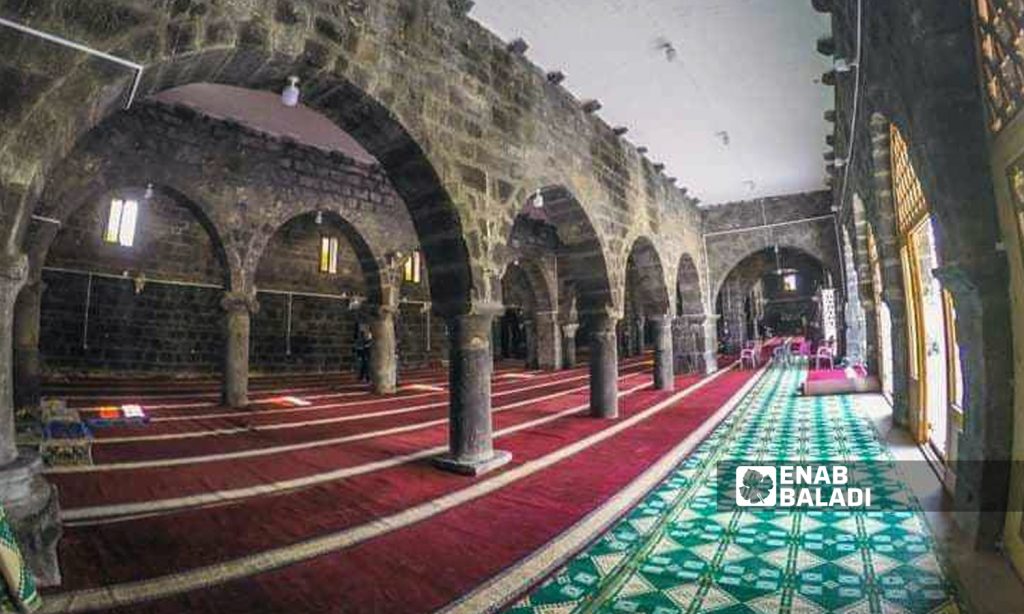Daraa – Halim Muhammad
During the latest military campaign on Daraa al-Balad, the Syrian regime forces deliberately targeted the city’s mosques even though they were not located on conflict lines or taken as headquarters by local fighters.
On 5 September, the regime’s artillery attacked the al-Omari Mosque with an elephant rocket, causing material damage to its building.
Previously, the regime forces targeted the Dr. Ghassan Aba Zaid Mosque in the al-Arbaeen neighborhood and the al-Mansour Mosque in the Tareeq al-Sad neighborhood.
Syrian regime retaliating against Daraa by targeting mosques
The bombing of mosques has raised questions among Daraa residents about the reasons for their targeting in every military campaign launched by the Syrian regime, as its forces spared no mosque their military operations in the latest offensive on Daraa al-Balad.
Activist Ahmed Shaheen, a resident of Daraa countryside, told Enab Baladi that the attacks on mosques are chiefly revenge attacks, as mosques are considered “the Qiblah and compass to all Muslims.” He added, each mosque has a sacred symbolism to the people of Daraa, and the regime aims to hit that sanctity and undermine the locals’ morale.
Sixty-year-old Abu Mohammed from Daraa al-Balad said that the systematic bombardment of mosques is indicative of the regime’s militias’ sectarianism and that they are the prime controllers of the battle on the ground.
He added that the targeting of mosques is in no way coincidental, as the regime wanted to exact revenge on the birthplace of the revolution.
One of Daraa’s dignitaries told Enab Baladi on the condition of anonymity for security reasons that the regime’s attack on Daraa’s mosques is retaliatory, especially that the al-Omari Mosque was the center of the first-ever protest against the regime, causing profound hatred against all mosques.
Daraa governorate’s former governor during the opposition factions’ control, Ali al-Salkhadi, said that the regime’s targeting of mosques is an old new war strategy. In the 1980s, the regime stormed the city of Hama and destroyed its entire mosques and after the 2011 popular protests, mosque minarets were the first target of the regime’s ground and aerial attacks on Syrian cities and villages.
Al-Salkhadi said that the al-Omari Mosque was targeted by the regime despite being far from confrontation lines, adding that the mosque was never taken as a headquarters by local fighters.
He also pointed out that the Free Lawyers Association (FLA), human rights activists, and the legal office of the National Coalition of Syrian Revolution and Opposition Forces, also known as the Syrian Opposition Coalition (SOC), have documented all the regime’s crimes against the Syrian people, including the targeting of houses of worship.
Protocol I of 1977, an addition to the Geneva Conventions of 1949, prohibited all acts of hostility against historical monuments or places of worship that constitute the cultural or spiritual heritage of people and their use in support of military efforts.
The great symbolic value of the al-Omari Mosque
The bombing of mosques in Daraa, the al-Omari Grand Mosque, in particular, has caused great outrage among locals.
The al-Omari Mosque is of significant historical value and a revolutionary symbol for the southern region’s residents and Syrians in general. The same value has made the mosque a target for the regime’s forces, who turned its prayer halls into a battleground before destroying its historical minaret in April 2013, making it a “destroyed symbol.”
The al-Omari Mosque, which is one of the most important monuments in Daraa governorate, was built by and named after Caliph Omar Ibn al-Khattab. The mosque witnessed the outbreak of the first protest in the Syrian revolution on 18 March 2011 and became a center for coordinating revolutionary demonstrations and meetings.
The regime forces broke into the mosque at the end of March 2011. Back then, the forces wrote sectarian and indecent expressions on the mosque’s walls and claimed to have found a field hospital inside it, besides large sums of money.
In 2013, the regime’s aircraft bombed the mosque and destroyed its minaret. However, with the 2018 settlement agreement in Daraa, residents of Daraa al-Balad managed with civil efforts to put the mosque back in service and resumed prayer holding there.
The head of the Military Security branch in Daraa, Brigadier General Luay al-Ali, threatened Daraa’s dignitaries last July that he would demolish al-Omari Mosque and remove its rubble if residents of Daraa al-Balad did not accede to the regime’s demands in handing over their arms and stop resisting the entry of regime forces to the city.
Indeed, the regime forces bombed the al-Omari Mosque this September, causing damages that residents were able to repair as part of “voluntary efforts,” and on 10 September, they held the Friday prayer there.
Al-Salkhadi said that the mosque has a revolutionary and political peculiarity, being the lighthouse of the Syrian revolution and the birthplace of the first protest against the regime.
Recently, Daraa governorate became subject to a military escalation when regime forces besieged the city of Daraa al-Balad for nearly 80 days and cut off basic services like water, electricity, and flour. The city was bombed by artillery shells and Golan, volcanic, and elephant rockets, in an attempt to storm the city.
Earlier in September, the Daraa Central Committee (DCC) and Daraa’s dignitaries reached a ceasefire agreement with the Syrian regime’s security committee. As by the agreement, the status of hundreds of wanted people by the regime was settled, and arms were surrendered to the regime.
The new agreement also stipulated searching civilian houses in the presence of Russian forces and the Russian-backed 8th Brigade, besides the deployment of nine military posts in and around Daraa al-Balad.











